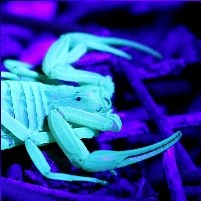Last updated: February 1, 2017
Article
Arizona Bark Scorpion

NPS Photo/ Eric Hope
Scientific Name
Centruroides sculpturatus
Identification
- Bark scorpions are relatively small, and have a maximum length of about 2.5 inches (6.4cm).
- Their bodies are tan, and their backs are slightly darker in color.
- Under UV light, these scorpions will glow a bright bluish color making them easy to spot.
- They are nocturnal and are generally only seen at night.
Habitat
- Bark scorpions are most frequently found inside the Grand Canyon, but they can be found on the Rims.
- While they are well adapted for the desert and can be found in all parts of the Grand Canyon, bark scorpions prefer riparian (streamside) habitats.
- Because they are nocturnal, and hard to see when they are still, bark scorpions are most commonly seen crossing trails at night.
Behavior
- Bark scorpions use their pincers to grab small insects while they sting them with their highly venomous tail.
- Their venomous sting isn't always enough to protect these animals, and bark scorpions are eaten by bats, mice, lizards, tarantulas, and birds.
- Females give birth to live young and carry up to 30 on their back for up to three weeks- protecting the young until they have their first molt (when they shed their exoskeleton to grow larger).
- Arizona bark scorpions hibernate throughout the winter (until evening temperatures consistently stay above 73°F/23°C) in groups of up to 40 individuals.
- Bark scorpions can live as long as 5-7 years. Because their hard exoskeletons do not change in size, scorpions and other arthropods must shed their current exoskeleton and grow a new one as they grow larger.
- Bark scorpions are the most venomous scorpion in North America, and the most commonly seen scorpion in the Grand Canyon. Watch these amazing animals, but do not handle them.
